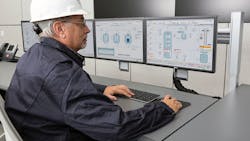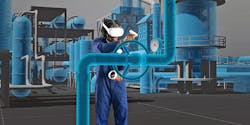Even in the early days of computing, businesses were looking at computers as tools for setting up complex simulations. Some credit Keith Douglas Tocher for developing the first discrete-event simulation program in 1960. Dubbed the General Simulation Program, his program used a common structure to execute a range of simulations.
Today, computers can simulate any industrial application for use in training or for control and analysis of specific automation operations. And when it comes to training industrial workers in their tasks, the confluence of simulation and workflow management are growing closer together.
“For example, a digital workflow for a machine setup process will provide the steps to take in addition to knowledge that gives the employee instructions on how to complete a task,” he said. “If there is an issue with a step or the employee has a question, he or she can trigger a request that automatically gets routed, assigned, and actioned by a support team.”
Allen noted that, despite the similarities among industrial companies when it comes to their interest in workflow software, “we’re seeing different industries use workflows in different ways to solve challenges. Organizations with large complex supply chains are prioritizing workflows that improve communication and collaboration. Companies with a large population of front-line factory workers are using workflows to improve overall equipment effectiveness and productivity. And those with major technology investments are using workflows to identify and reduce cyber risk.”
According to Allen, companies such as Jabil, Siemens, and Owens-Illinois are just a few of the hundreds of companies that ServiceNow has helped in the industrial sector.
Training simulations The line between digital twins and simulations can blur a bit when it comes to training applications. The principal difference is that digital twins are connected to their real-world counterparts and reflect their operations in realtime—often including the ability to control them remotely. Simulations, on the other hand, are not typically connected in a live fashion with the physical equipment they represent. As such, simulation software replicates the actions of real-world equipment offline, providing a safe space for trainees to interact with the equipment.
Pramesh Maheshwari, vice president and general manager of lifecycle solutions and services at HoneywellProcess Solutions, sees aging workforces and increasingly complex technologies as mega-trends putting pressure on industrial companies to improve their training programs. He said, “More than ever, industry needs training and development solutions that empower workers to improve plant performance, uptime, reliability, and safety. One of the best ways to do this is by simulating real-world environments and rare, but critical plant operation and maintenance scenarios to enable safe, hands on learning away from the hazards of a plant.”
Emerson, for example, is using simulation to train refinery workers in Canada. Working with the refinery, Emerson developed a digital twin of the refinery’s production control system integrated with a high fidelity simulator. Here, Emerson’s DeltaV Simulate virtual control system is used to mirror the refinery’s operator stations, engineering stations, process controllers, and system functions. Emerson’s Mimic software then simulates the processes, equipment, transmitters, and final control elements with operation based modeling objects.
This system provides trainees with virtual controls, graphics, and alarms identical to those in the refinery and allows the use of all Emerson DeltaV software for training and development without the refinery having to purchase duplicate control hardware and system licenses.
Another application benefitting from simulation is training workers on computer numerical control (CNC) machines, such as milling machines, routers, lathes, and laser cutters. Siemens offers a CNC training platform for creating and operating a CNC digital twin using the company’s Sinumerik 840D numerical control (NC) and NX software.
Trainees can operate an online digital twin of a CNC machine at their own PC as well as safely test and optimize NC programs without potentially damaging the real machine.
And Honeywell recently released an updated version of its Immersive Field Simulator, IFSR120, described as a virtual reality (VR) and mixed reality training tool based on a digital twin of a plant’s operations. With this technology, events like primary failures and switchovers, as well as cable and power supply failures, can be simulated.
Gamification
Though not a new concept, gamification is a trend
gaining ground in the simulation software arena. The
Merriam Webster
dictionary defines gamification as
the process of adding games or game-like
elements
to a learning a task to encourage participation.
According to 3D game tech company Juego Studios, gamification training simulations are a good way to package complex content into interactive visual modules. Trainees learn complex tasks within a game like environment. Realistic simulations make dry content interesting while enabling better understanding and memory retention.
Juego’s Unity3D game engine creates immersive 3D worlds that allow users to interact with complex equipment and large machines. The Unity engine allows development of cross-platform training applications for mobile devices, desktops, and/or web browsers. Training simulations can walk workers through safety procedures, operations, and maintenance, as well as repair and assembly processes.
As an example, Juego Studios developed a 3D simulation training module for employees working on drilling operations with RFID tagged pipes. The training module simulates the industrial environment with 3D images of equipment and tools. It also provides instructions for fitting RFID tagged pipes and drilling operations.
Another company in the simulation arena, SimutechMultimedia, uses gamification in its simulation software to train manufacturing workers. The company’s Simutech Training System teaches troubleshooting skills to workers operating and maintaining industrial control systems.
The system takes trainees through a six-step approach to troubleshooting circuits and helps them develop effective techniques for safely navigating industrial electrical controls, motors, and programmable logic controller (PLC) circuits. Workers can personalize training progress and managers can continuously monitor their development.
Leaders relevant to this article:




